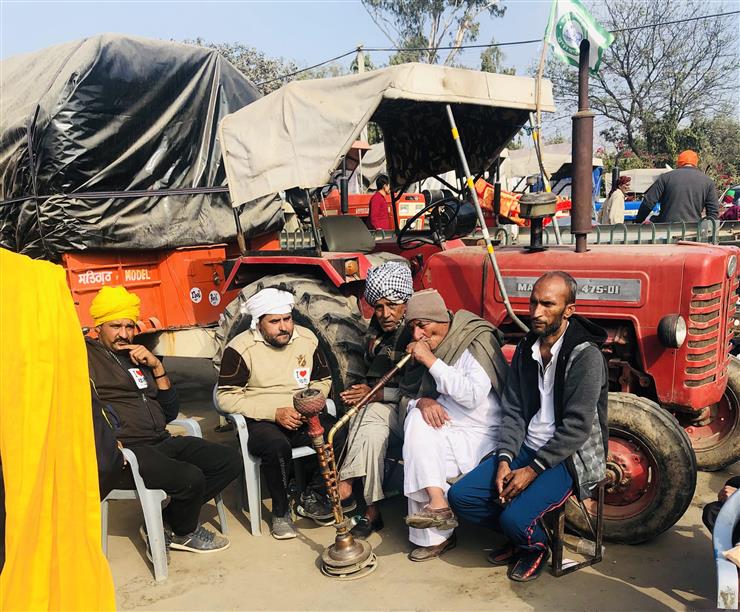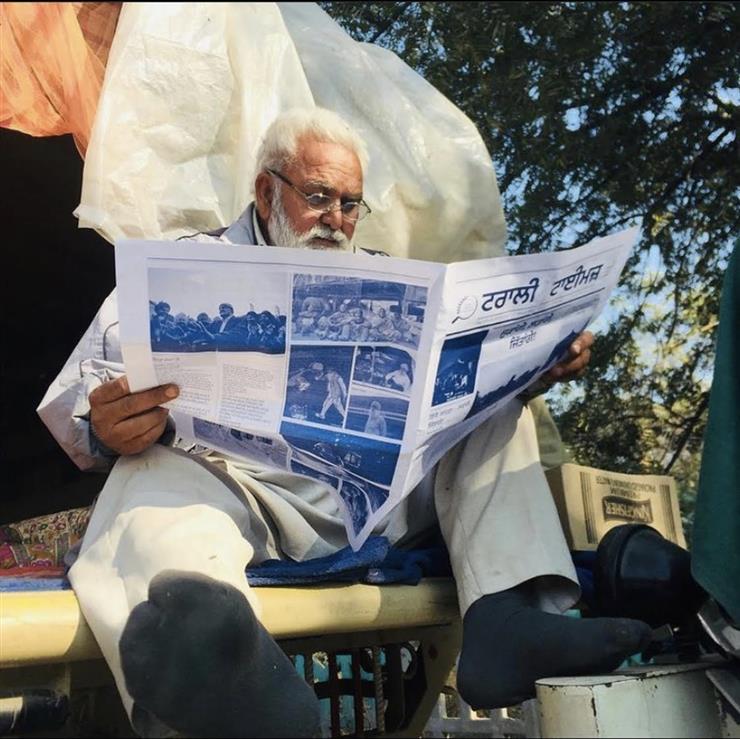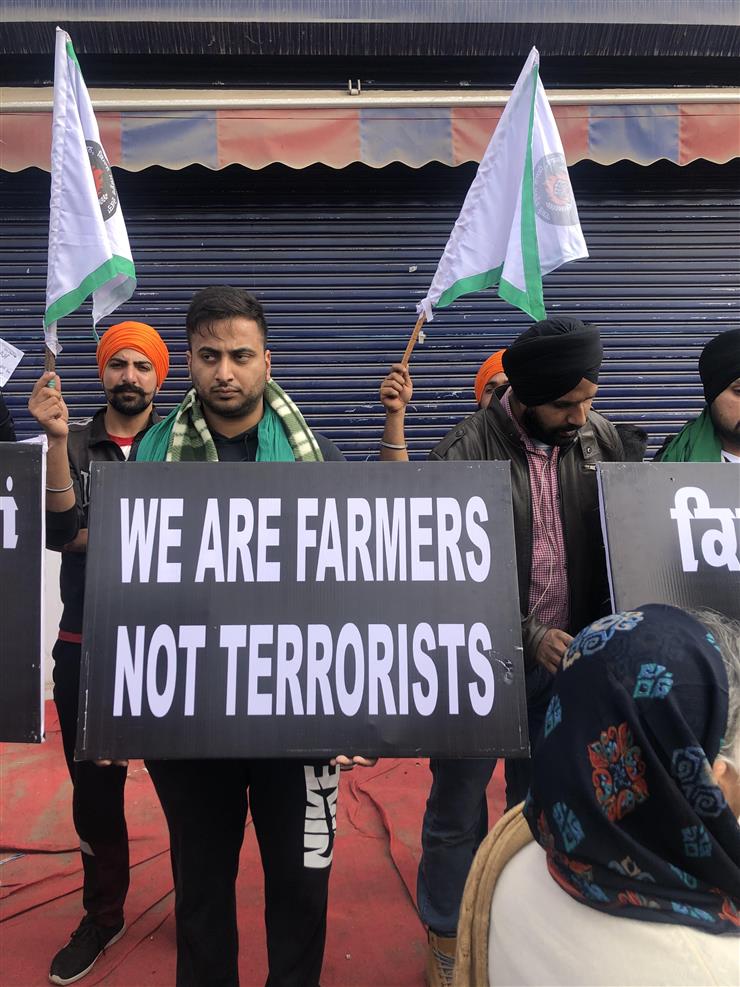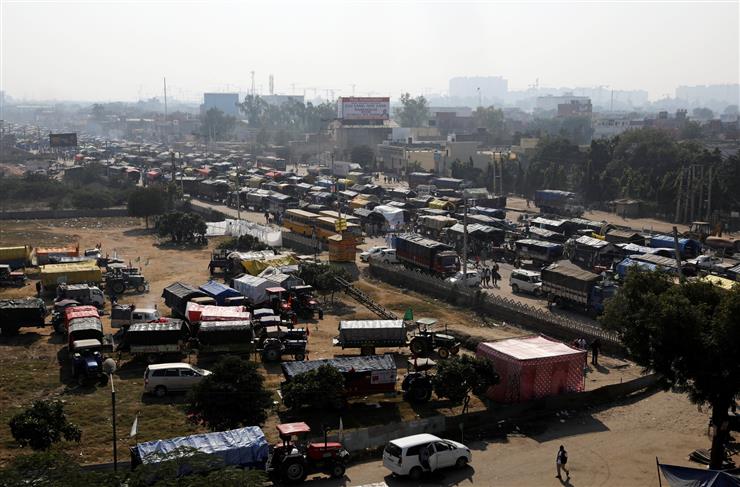Sindhu (Delhi): Urban journalists who may have never visited villages or seen the life of working farmers ask odd questions to the protesting farmers’ leaders that reflects more on them than the farmers at the Shinghu Border Delhi.
To abreast the protesting farmers about the latest developments, the innovative Punjab Farmers and their young generations who appears to be IT savvy have launched a newsletter of four pages-Trolley times.
About 2000 copies of its first issue were circulated among farmers at Shingu as well at Tikkari. Copies of Trolley times were also pated on trolleys at strategic points for easy access to anyone interested in the latest news and developments of the protesting farmers' demands, Supreme Court Intervention, and government’s vilification campaign to demonise protesting farmers.
the idea of a newsletter in Hindi and Punjabi was born in the clusters of farmer’s trollies at the Singhu border, where thousands have been protesting against the 3-farm laws since November 26. Finally, on at least 2, 000 copies of the four-page newsletter —with its masque head Trolley Times, rolled out of Laser printers and reached in the hands of the protesting farmers at Singhu and Tikri borders Thursday night.
While Maavi said the newsletter is also a way of recording developments for posterity as well showcasing the “intellectual strength of the farmer community”. Dhaliwal said. “We were compelled to bring out this newsletter because the Sarkari media have been spreading disinformation as well as camping against their protests to show every activity here pale light. Moreover, the farmers do have much faith in the Delhi media. Once the idea took birth in our discussions at night meetings inside the trollies get-togethers, the farmer Narinder Bhinder in whose trolley the discussion used run into midnight. Bhinder formed a team of volunteers and put a proposal together, approached the union leaders, farm law experts, and farmers at the two borders for support. The idea got instant approval.
The bi-weekly newsletter’s first issue front page highlights “Judaange, Ladaange, Jeetange!”, which has photographs, cartoons, poems, news reports, and opinion pieces written by union leaders and protesting farmers. Of the four pages, three pages are in Punjabi while one is in Hindi.
I came from Chandigarh to spent two-day with the protesting farmers to have a first-hand feel of the situation. It looks like a village spread on an Island on both sides are modern showrooms and high-rise malls and buildings.
Many residents of the localities around here share sitting on mates with farmers’ delicious cooked food and several types of sweet dishes, fruits at hundreds of langers spread over in several
Although the morchas at Tikri and Singhu borders are spread across several kilometers from each other, the only way to maintain link now is the Trolley Times. Through the newsletter, the message from the stage, the development in talks with the government, among other such reports, can easily be provided to farmers to meet their urge for news, information around and knowledge., ” said the copy-writer Surmeet Maavi (46), who started Trolley Times with the assistants of Barnala-based young articulate documentary photographer Gurdeep Singh Dhaliwal (27).

Haryana farmers basking in Sun at Shinghu border , Delhi
While Maavi said the newsletter is also a way of recording developments for posterity as well showcasing the “intellectual strength of the farmers community”. Dhaliwal said. “We were compelled to bring out this newsletter because the Sarkari media have been spreading disinformation as well as camping against their protests to show every activity here pale light. Moreover, the farmers do have much faith in the Delhi media. Once the idea took birth in our discussions at night meetings inside the trollies get-togethers, the farmer Narinder Bhinder in whose trolley the discussion used run into midnight. Bhinder formed a team of volunteers was put proposal together, approached the union leaders, farm law experts, and farmers at the two borders for support.

Farmer reading Trolley Times a Singhu border, Delhi
Immediately, the idea was also uploaded on social media, the response was highly encouraging. Our apprehension of filling the pages got vanquished as within a few minutes several hundreds of emails arrived with lots of support, many I haven’t even been able to read yet, ” said Dhaliwal.
For thousands of farmers from Punjab protesting at the Delhi border, it is the trolleys attached to their tractors that have come up as temporary homes with waterproof covers, makeshift beds, and even charging points for the cell phones.
At night trollies are light up with solar systems installed over the trollies or having a direct connection from Tractors’ batteries. This way facility has also been provided in trollies for charging the smart mobile phones. The trolleys also often turn into a makeshift stage from where farm leaders address the gathering with their voice amplified several times courtesy of the loudspeakers fitted on the tractors.

Protesting farmers shedding false allegation of being terrorists at Shinghu Border, Delhi
While hundreds of thousands of such tractor-trolleys are already stationed at the Delhi border, several more are on their way to the national capital from Punjab, Rajasthan, Haryana, Uttar Pradesh. For the Punjab farmers living in this style is not new, they have been doing for this for since their childhood participating in religious festivals like Holla-Mohalla (Anandpur Sahib), Baisakhi (Talwandi Sabo), Maghi Mela (Mukatsar), Jor Mela at Fatehgarh sahib, and many more religious occasions.

Tractor-trolleys everywhere on way to Singhu border, Delhi
What surprises the Delhiwals and Sarkari media the way the farmers adopted the lifestyle at the Delhi protests venue, with any show of anguish and with a feeling of hate against anybody.
When questioned about uncomfortable living conditions and harsh chilly weather the farmer's answer is, we live in Chardikala (In high spirits).
Email: cmsingh.india@gmail.com